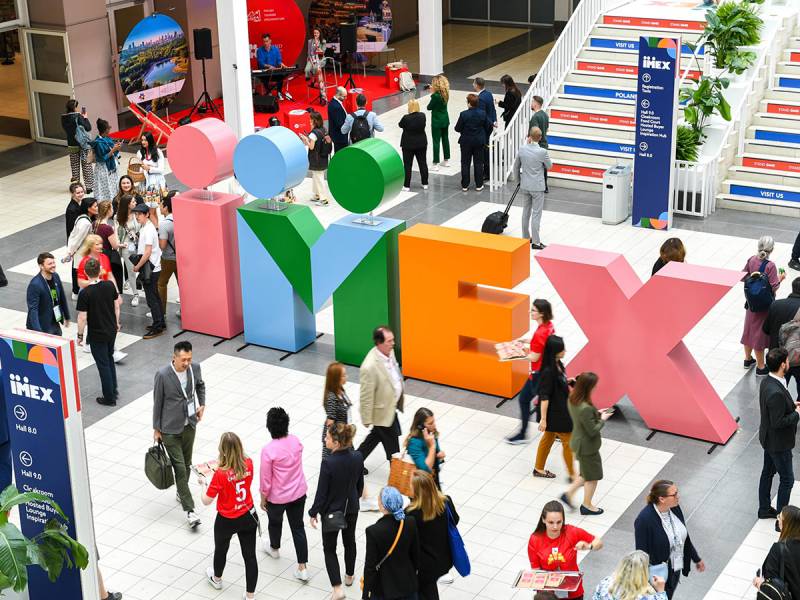IMEX Association Focus: From Story-telling to Story-feeling!

Photo credit: IMEX
As event professionals we know that an event is so much more than a one-off experience. When designed well, an event can move us emotionally, create memories and change behavior.
As the founder of the School of Experience Design, Pigalle Tavakkoli (on the right) has this at the core of her practice. She helps teams to design emotionally charged, unforgettable experiences with long lasting impact.
We caught up with her ahead of her Association Focus session at IMEX Frankfurt to talk all things experience design.
What is experience design and what’s its impact?
 Experience Design allows us to go beyond simply designing the form and function of a product, event or service, to also design the attendees’ emotions, memories and behaviour. It moves us from designing by intuition, to designing with intention how attendees feel and think, ultimately transforming their behavior forever.
Experience Design allows us to go beyond simply designing the form and function of a product, event or service, to also design the attendees’ emotions, memories and behaviour. It moves us from designing by intuition, to designing with intention how attendees feel and think, ultimately transforming their behavior forever.
If event professionals wish to change behavior I recommend - although this might sound counterintuitive - that they don’t start by trying to change behavior. This is because changing behavior is the hardest thing to do! As humans we're naturally risk averse and don't wish to move out of our comfort zones and change. Instead, event professionals can start by identifying the types of emotions they want to change, and then the shifts in thoughts and perspectives they wish to bring about. When these are done effectively, a natural outcome will be a change in behavior. This is summed up by my ‘Emotion Change Equation’, a method which helps to change emotions and thoughts, which then leads to changes in behavior.
Designing emotions is crucial - although we like to think we're rational and logical, neuroscience research shows the unconscious drives up to 98% our decisions. This means we’re a highly emotional species which acts first and then considers our decisions afterwards. I encourage us to embrace the fact that we’re a highly emotional species, and lean into the 98% as an exciting space filled with design opportunities.
How can planners evoke emotion through their events?
The most powerful way to evoke emotions is through storytelling. Neuroscientists have found that when we receive facts and data driven information, this activates two main areas of the brain. However, when we receive emotionally rich information, it activates up to seven areas of the brain, including the emotion and memory centers.
Emotionally-rich information is the basis of storytelling – and there's a skill to crafting the right story! The stories told by organisations tend to focus on the brand, leaving the audience to ask ‘how does this relate to me and my life?’.
In order to truly engage, organisations should move from brand storytelling to customer storyfeeling - a term that I’ve coined. From this perspective, they use their events to tell stories about attendee needs and aspirations, and how the product or service will benefit them and their lives. Storyfeeling, when done well, sparks meaningful connections and builds long-lasting relationships between the attendee and an organisation.
When events spark emotions and thoughts, they form unforgettable memories. Long after the event, whenever the attendee remembers the experience, the same emotions and thoughts come flooding back which inspires them to continue to change. This then becomes a transformative experience for the long term.
Can you share some examples of changing behavior?
A long-term behavioral outcome could be that a planner wants attendees to be more connected to their community. I’ve developed a ‘Transformation Design Strategy’ framework which starts with identifying which emotions, thoughts and actions are needed to help attendees feel that community connection. Once these have been identified, they become the levers to activate change. Across the next steps, the planner designs the customer journey with focus and intention for greater success.
The framework also helps the ideation and design process to flow more smoothly, because they’re applying a strategic approach to the design process. In effect, they’re reverse engineering the usual design process by working backwards from the long-term impact and transformation goals to reveal what they need to design to get there.
What prompted your move into experience design?
Having studied theatre and worked backstage in London’s West End theatres, I learnt techniques to remove the stage and place the audience as the central protagonists in the story. Ten years in fashion followed, working for designers such as Alexander McQueen, and then running my own fashion label. This led onto a 15 year career as a creative producer, working with leading scientists and artists to design immersive story worlds across live and digital platforms.
My very first event was for the Victoria & Albert Museum (V&A) in London. The brief was to attract a young fashion forward audience to discover the little-known theatre museum. I took over the whole building and transformed it into an immersive story world, with role-playing performers guiding guests throughout. We sold out on the night, with 1,000 fashion forward guests attending. Initially, they observed the story as passive spectators, but mid-way their behavior changed before my eyes. There was a magical moment when the tables turned and the audience overtook the performers to spontaneously perform themselves – someone took a seat at the piano to play, another began singing, others danced with each other. They responded emotionally to the story, which lead them to become actively involved and generate incredible energy and excitement.
This magical moment helped me see first-hand the immense impact a story-rich experience could deliver. I decided to bring together my background in the arts and sciences, to harness them and create experiences which spark emotional reactions and change behaviour. At the time, I didn't know what to call my approach – this was over 15 years ago and the term experiential wasn't even yet in use! Today there’s a much broader understanding, and I’m proud to have been championing Experience Design since those early days, and just as passionate to equip others to design transformative experiences.
IMEX’s Talking Point is Impact - what does impact mean to you?
Impact is the change in emotion, thought and behavior we continue to feel and carry out long after the experience has taken place. Eventually, impact will no longer be impact; it will become integrated into our daily lives.
Pigalle Tavakkoli is the founder of the School of Experience Design and speaker at IMEX Frankfurt 2024. Interested in experience design? Discover more sessions at IMEX dedicated education track here.
Association Focus is sponsored by Amsterdam Convention Bureau and takes place at the Sheraton Frankfurt Airport Hotel on Monday May 13, followed by Association Social at the Frankfurt Marriott Hotel. It is delivered in association with ICCA, AC Forum and ASAE.
Register to attend IMEX Frankfurt from May 14 to 16 – for free - here.
Other Articles
About Us
Supported by the Union of International Associations (UIA), the International Association of Professional Congress Organisers (IAPCO) and the Interel Group, the global public affairs and association management consultancy, Headquarters Magazines serve the needs of international associations organising worldwide congresses.













